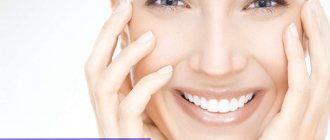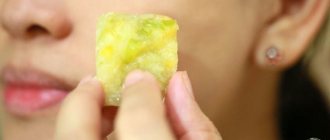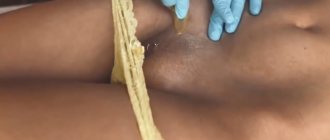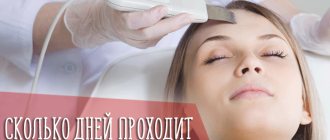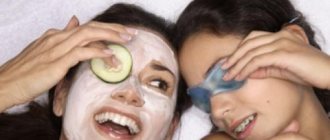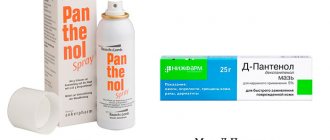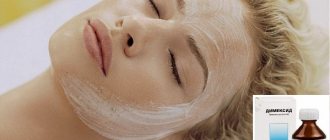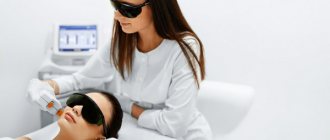Face cleaning
At home, cleansing the skin of the face does not always give the desired result if its characteristics include increased oiliness. Then you should contact a specialist who will carry out professional cleaning. In addition, it complements peeling well.
The purpose of the procedure is to clean pores mechanically or mechanically, nourish, moisturize the skin, eliminate blackheads and smooth out unevenness, exfoliate the stratum corneum. Cleaning can be:
- Mechanical (manual) is the most effective way to remove pustular rashes and comedones, including deep ones. Suitable for oily and combination skin.
- Hardware - ultrasonic or vacuum peeling, stimulates blood circulation and lymphatic drainage, cleanses pores and massages the skin. Suitable for both normal and oily types.
Before cleansing, the skin must be prepared to maximize the effect of the procedure. This preparation includes: removing makeup and thoroughly cleansing using a scrub, toning the day before and in the morning. For dry skin, you should make a nourishing mask. Immediately before the procedure, the skin is steamed and treated with an antiseptic.
After cleansing, the skin should recover. This usually happens within 3 days if you follow all the rules of care after cleansing your face.
Care after mechanical cleaning requires special attention, as the skin is injured and wounds, inflammation, and red spots may appear. A rash may also appear if one of the wounds becomes infected.
What can't you do?
The use of scrubs and other aggressive cleansers is not recommended. Physical activity, thermal procedures, sunbathing and visits to the solarium are limited during rehabilitation. You cannot separate the crusts yourself. Usually 3 days are enough. After this, you can switch to regular skincare products.
How to help your skin?
- Use proven mild hypoallergenic cleansers and moisturizers.
- Be sure to wear sunscreen even if it is cloudy outside.
- Treat micro-wounds with antibacterial agents.
- Drink enough water to hydrate your skin from the inside.
- If a rash appears, you can make a mask from white or blue clay.
1.What types of peelings are there?
Facial peelings are performed for various problems such as pigmentation, wrinkles, and age-related sagging.
There are three types of chemical peels:
superficial peeling
This peeling affects the upper layer of the skin and, if the rules are followed, is one of the most gentle peelings.
Superficial peeling can be done at home with certain preparation.
medium depth peeling
With this type of peeling, the acid penetrates the dermal tissue. After this peeling, the face takes much longer to recover and requires careful care.
deep chemical peeling
This is a very complex and painful procedure that should only be performed in special clinics by a qualified cosmetologist.
Medium-depth and deep chemical peeling procedures are carried out only by qualified cosmetologists; these peelings are strictly prohibited at home!
Composition of Solcoseryl and Panthenol
Solcoseryl is a drug that contains bovine blood extract. Its peculiarity is that the main substance is freed from protein particles.
In addition, the ointment also contains auxiliary substances:
- cetyl alcohol;
- cholesterol;
- white paraffin;
- methyl parahydroxybenzoate;
- propyl parahydroxybenzoate;
- water.
These components together form a homogeneous mass. Its color can range from white to yellowish.
Panthenol ointment contains dexpanthelol as the main active ingredient. Additional ingredients are glycerin, paraffin, lanolin, mineral oil, cetyl alcohol, distilled water. The spray contains several other substances. The composition is supplemented with liquid wax and peracetic acid.
Saving skin correctly
Care for skin injured by acidic compounds or laser beams must be consistent and thorough. Skin damaged by peeling, under which a new epidermis is actively forming, must be carefully cleaned with sulfate-free face washes, moisturized with natural masks and decoctions, nourished and restored with special creams, protected from ultraviolet radiation and disinfected with antibacterial drugs.
The basic rules of post-peeling care are common to all anti-aging techniques:
- in the first few days after peeling, it is advisable to touch the injured facial skin as little as possible, so the consistency of all cleansing and moisturizing products should be gel or foam: they will be quickly absorbed without additional rubbing;
- Moisturizing is a separate mandatory stage of post-peeling skin restoration. Drugs that help normalize the water-lipid balance eliminate the feeling of skin tightness and are a good prevention of scarring;
- the formation of renewed epithelium is stimulated by regenerating preparations containing retinol, panthenol, and omega fatty acids. Creams based on these components help accelerate the healing of the skin;
- In the case of deep peels, it is necessary to add antibacterial drugs to the standard set of post-peel care products that will prevent infection of young skin. As well as antioxidant compounds containing tocopherol or selenium;
- in the first days after the exfoliation procedure, it is advisable to wash your face with slightly acidic water;
- The crusts formed after acid or thermal peeling cannot be touched. They are a natural barrier for young epithelium, protecting it from atmospheric pollution and bacteria, and also prevent the formation of scars and screeds;
- During post-peeling skin regeneration, refrain from applying makeup and using compositions with abrasive particles;
- Apply a regenerating cream or gel to your face 3-4 times a day, as well as a product that protects against ultraviolet radiation with SPF of at least 30.
Peculiarities
During the manipulation, a chemical substance is applied to the skin, previously cleaned of dirt and cosmetics. After 5 minutes, it is washed off and, if deep exfoliation is necessary, applied several more times.
After the procedure, the cosmetologist cleanses the skin of product residues and applies healing ointment - Bepanten, Panthenol.
In some cases, the peeling composition remains on the face. You need to wash off the solution from the skin and apply a healing or baby cream yourself, most often 5-6 hours after the procedure.
How to properly use Solcoseryl for sunburn
Solcoseryl for sunburn should be used only for the treatment of mild skin damage, that is, the first and second degrees of severity, which are characterized by redness and the appearance of blisters, respectively. It must be taken into account that the surface area of the injury should not be large, otherwise resorting to self-medication is prohibited.
If these conditions are met, then you can proceed to applying the drug:
first, it is important to disinfect the area being treated, because the drug does not contain components that could fight dirt and harmful bacteria; Then you can begin directly applying the medicine, rubbing it in a circular motion; there is no need to put pressure on the damaged skin.
However, if the treatment does not produce results within 2-3 weeks, then you need to consult a doctor who will help the individual patient choose another method of recovery, having professionally assessed the injury.
How to apply cream correctly
Rules for applying cream to cleansed epidermis:
- Apply to the skin in a thin, even layer along massage lines, pre-treated with tonic or foam;
- do not rub the cream in - this may further injure the dermis;
- during the formation of a superficial crust, the frequency of application ranges from 3 to 6 times per day, then the number of daily applications is reduced to 2 times.
Expert opinion
Anastasia Zaslavskaya
Dermatologist, cosmetologist
When choosing a cream, you should avoid products that contain chemical compounds or fragrances - this can cause an allergic reaction to spread or cause hyperpigmentation.
Before the first application, it is important to do a test to identify an allergic reaction - for this, a small amount of cream is applied to the wrist and left for 10-20 minutes. If after a while there is no redness, itching or burning, the product can be safely used for its intended purpose.
General recommendations during the post-peeling period
During the recovery period, it is important to adhere to the following recommendations:
- For the first 12 hours after peeling, you should not touch your face with your hands. In case of superficial cleansing, it is not recommended to wash your face for 24 hours; with medium peeling, you should avoid water treatments for 2–3 days, and after deep peeling, you should avoid contact with water for 4–5 days.
- Remove remaining water from the face using cosmetic wipes. The first time is to cleanse your face with foam or gel products - they are absorbed into the deep layers of the skin without additional rubbing.
- For several weeks, avoid cosmetic products containing sulfates or alcohol.
- Do not use the sauna, solarium or swimming pool.
- Avoid using scrubs as this may cause scarring.
- Before each exit to the street, treat your skin with products with a high level of protection from exposure to sunlight.
- Drink at least 2 liters of water daily - this will help normalize the water-lipid balance. Eliminate spicy foods and alcoholic drinks from your diet for 2–3 weeks.
To speed up the regeneration process, it is recommended to apply products with a healing, regenerating and moisturizing effect to cleansed skin every day. Any cream is allowed to be used after a crust appears on the cleansed skin, which is strictly forbidden to eliminate on your own.
If swelling and redness do not subside a few days after peeling, you should be examined by a dermatologist, who will identify the cause and prescribe the necessary medications to eliminate side effects.
After medium or deep exfoliation, an antibacterial agent should be added to post-peeling care - it minimizes the risk of infection spreading through the skin.
Opinion of cosmetologists
Peeling renews and heals the skin. However, this is a complex procedure that affects the inner layers of the epidermis.
We will provide answers to the main questions asked to cosmetologists regarding facial care after the procedure:
- Can I use foundation? - Definitely not. Clogging pores with foundation will lead to skin infection. Foundation does not hide peeling, it highlights imperfections.
- What can I do to make facial redness go away faster? – Don’t rush things, skin regeneration processes should occur naturally. Give your body a rest: give up spicy food and alcohol, visit the bathhouse, sauna, fitness center and swimming pool for 2 weeks.
- Is it possible to remove peeling on your own? - No you can not. The use of scrubs or other cleansers is prohibited to avoid the formation of deep scars, which will be problematic to get rid of.
If you suspect an infection, you should immediately contact a cosmetologist.
Top 10 creams and ointments after peeling
Here are the best creams and ointments for skin care during the post-peeling period:
Bepanten
Prescribed for medium or deep exfoliation. The impact of peeling compounds destroys not only dead skin cells, but also the protective barrier of the skin. The main ingredient is dexpanthenol, which upon penetration into tissue is converted into pantothenic acid
In this form it is important in the process of cell metabolism. Helps accelerate the regeneration of tissues and mucous membranes
Used to heal microcracks, skin irritation, and exposure to ultraviolet radiation. You can buy Bepanten in the form of an ointment or cream, the cost is about 500 rubles.
Panthenol D
The main active ingredient is dexpanthenol or provitamin B5. A water-soluble element in the form of coenzyme A is involved in regeneration processes. Prescribed for the formation of new tissues, healing of the skin after injuries and burns. As a result, use can speed up healing, reduce redness, and form a protective barrier of the integument. The cost of Panthenol D depends on the form of the drug, the price varies from 80 rubles. up to 450 rub.
Solcoseryl
Contains blood proteins from calves, animal origin of the composition ensures accelerated healing after chemical peeling. Nourishes, oxygenates damaged cells, promotes rapid restoration of irritated tissues. Activates collagen synthesis, thereby enhancing the exfoliation effect. Promotes accelerated healing, relieves inflammation and swelling. It is used not only during post-peeling care, but also in case of complications, in case of tissue burns. You can buy Solcoseryl for 320 rubles.
Dexpanthenol
The ointment includes vitamin B5, which is involved in carbohydrate and lipid metabolism. This is an indispensable element for tissue regeneration and increases the density of collagen fibers. Penetrates well into the deep layers and is prescribed for tissue restoration and normalization of cellular metabolism. Recommended for quickly restoring water balance and protecting against aggressive environmental factors. You can buy Dexpanthenol for 140 rubles.
Baby cream
Available in different brands and compositions, including plant extracts, oils, natural animal fats, beeswax, silicon dioxide, kaolin and others. It has nourishing and moisturizing properties, protects the skin from adverse environmental factors. Suitable for post-peeling care, protects the skin from changes in dry air temperatures. The price of baby cream depends on the manufacturer, ranging from 30 rubles. and up to 500 rub.
Traumeel
The ointment contains extracts of calendula, witch hazel, echinacea, yarrow, chamomile, daisy, arnica, St. John's wort, and belladonna. It has an anti-inflammatory, analgesic effect, relieves irritation and discomfort after exfoliation. Eliminates swelling and redness, strengthens thin capillaries. Restores the protective barrier of tissues and is also prescribed to correct complications after peelings. You can buy Traumeel for 550 rubles.
Vegefarma Cream
Has anti-inflammatory, moisturizing properties. The composition is represented by rapeseed and sunflower oil, milk proteins, fireweed and chamomile extracts. Normalizes the skin's hydrolipid barrier after sun exposure, laser therapy or exfoliation. It has a bactericidal effect and prevents the development of infection. Soothes redness, irritation, softens dry, dehydrated dermis. You can buy Vegefarma Cream 50 ml for RUB 1,240.
Christina
Post-peeling regenerating cream Christina with a tonal effect contains zinc oxide, shea butter, rosehip, jojoba, carnauba wax, red clay, alaria extract, vitamins A, E, bisabolol. Used in a professional exfoliation program to protect skin from ultraviolet radiation and free radicals. The cream is intended for the care of oily, problematic, normal and dry dermis. You can buy it for 2900 rubles.
Methyluracil
Ointment for the treatment of various dermatological diseases, also used for poorly healing wounds. It has photoprotective properties and protects skin from ultraviolet radiation. In some cases, burning and allergic reactions are possible. Prescribed when complications occur after exfoliation. You can buy Methyluracil for 100 rubles.
Hydrocortisone ointment
Contains hydrocortisone acetate, as well as lanolin, pentol, stearic acid. Relieves discomfort symptoms during the healing period after medium and deep peeling. Reduces swelling, redness, has an antiallergic effect. You can buy hydrocortisone ointment for 35 rubles.
Pharmacy names of dexpanthenol
The name of the drug depends on the manufacturer producing it. In the pharmacy you can find the following names of the drug:
- D-Panthenol (Nizhpharm);
- Panthenol-ratiopharm (Ratiopharm);
- Dexpanthenol (Vertex);
- Panthenol (Micropharm);
- Panthenol ZD (Green oak grove);
- Panthenol Forte (Libriderm);
- Pantoderm (AKRIKHIN);
- Bepantent (Bayer Consumer Care AG).
The composition and release form depend on the pharmaceutical company that produces the drug.
To treat acne, various forms of dexpanthenol can be used in addition to ointment, which, due to its dense consistency, clogs pores and can contribute to the deterioration of the condition of the skin.
HEALING
Such phenomena as redness (erythema), dehydration, swelling and itching are considered absolutely normal after peeling. These side effects accompany the healing of facial skin, especially in the first 12 hours after a “controlled chemical burn,” as peeling is often called in professional circles. To alleviate these symptoms, you can use pharmacy ointments and creams specially designed for tissue regeneration: Bepanten, Panthenol, and others like them.
Bepanten for healing with vitamins
Bepanten cream, produced in Germany, was specially created for the regeneration of damaged and irritated skin with redness (including children's skin). This is one of the most popular drugs in its category with multiple dermatological applications (burns, bedsores, tattoos, wrinkles). Bepanten promotes tissue healing after various types of peeling and enhances barrier functions.
Unlike the thicker ointment of the same name, Bepanten cream is absorbed faster, so it is preferable after peeling. Apply a thin layer to the skin for 5 days in the mornings and evenings. The main active ingredient of the cream is provitamin B5, supplemented with beeswax and almond oil. “Bepanthen Plus” also includes the disinfectant chlorhexidine.
Panthenol for healing
A more cost-effective alternative to Bepanten - D-Panthenol-cream - is also based on completely natural ingredients and dexpanthenol (vitamin B5), and therefore has gained popularity among nursing mothers in the treatment of cracked nipples and diaper rash in babies. On the farm, Panthenol cream is used not only for cosmetic purposes, but also after insect bites, sunburn, etc.
It is also available in the form of a spray, which is especially convenient when you don’t want to touch your itchy face again.
However, it is worth taking into account that D-Panthenol cream does not contain antibacterial components and is not suitable for daily use
Solcoseryl to normalize metabolism
Solcoseryl ointment for any skin type can replace Bepanten or Panthenol creams. Extracted from the blood of calves, the drug normalizes metabolism in the epidermis after chemical peeling, activates cellular respiration, relieves pain, accelerates regeneration processes, and normalizes impaired nutrition in tissues. Available in the form of ointment and jelly, suitable for use on the epidermis affected by acne and seborrhea.
Lyoton-gel for swelling and redness
Traditionally, Lyoton is used in the treatment of varicose veins, but in cosmetology it is used for the face against bruises and swelling, as well as rosacea. The principle of action is based on the beneficial properties of heparin: this substance is extracted from the liver and lungs of cattle and prevents blood from clotting. The product is economical: just squeeze out a small pea-sized amount of gel from the tube and apply with patting movements.
Troxevasin against edema
The special pharmaceutical anti-edema ointment Troxevasin is also not directly intended for the face, but its bactericidal properties help fight swelling and bags under the eyes, as well as vascular mesh, which is why cosmetologists love it. Its action is similar to Lyoton, but is designed for a longer period of use. Apply in the same way as Lyoton; can be used as a cream base for makeup, but be sure to avoid contact with mucous membranes. As an option, you can buy a cheaper analogue of Troxevasin - Troxerutin.
Uriage Pruriced gel for itching
French-made gel Uriage Pruriced with raspberries, isotonic water, calamine and Omega fatty acids helps relieve itching and burning even with chicken pox, not to mention peeling. The product, light in consistency, has a cooling effect, treats burns and prevents the formation of greasy stains on the collar. The hypoallergenic composition is suitable even for sensitive skin.
Acetylcysteine for pigmentation
The so-called “epidermal conditioner” based on the amino acid cysteine normalizes sebum production, has a wound-healing and antioxidant effect, and increases tissue elasticity. More suitable for oily skin. Helps prevent the formation of age spots after peeling. Available in powder form, for application to the face it is diluted with water to the thickness of village sour cream.
Leave a review, what do you like better: Panthenol or Bepanthen?
D-Panthenol
The Russian manufacturer Nizhpharm produces a medicinal product in the form of ointments and creams intended for external use. The ointment has a dense structure due to the content of petroleum jelly. It has a characteristic color (light yellow) and the smell of lanolin.
The cream has a lighter consistency, so it is preferable to use D-panthenol for facial acne in this form of release. It is characterized by white color, specific odor, homogeneity (homogeneity) and rapid absorption (absorbability).
The pharmaceutical company also produces D-Panthenol-Nizhpharm-Plus cream, which, in addition to the main active ingredient, contains chlorhexidine. The latter is known for its antiseptic properties, and is often used as an additional remedy in the treatment of acne. A similar drug is produced by the company Evalar.
Rating of the best ointments for wound healing, applicable in the first stage of treatment
| Rating | #1 | #2 | #3 | ||||||||||||
| Name | Levomikol | Eplan | Rescuer | ||||||||||||
| Points | 100080 | 100072 | 100072 | ||||||||||||
| Availability in the pharmacy network | 1007 | 1009 | 1007 | ||||||||||||
| Effectively eliminates pain and restores the affected area | 1009 | 1006 | 1006 | Ease of use | 1009 | 1007 | 1009 | Gentle effect on the body | 1008 | 1006 | 1007 | Light consistency and pleasant aroma | 1007 | 1008 | 1007 |
Levomekol
The active component of this drug is chloramphenicol; most microbes are sensitive to this substance. It also contains methyluracil, which has the unique property of increasing the natural immunity of cells. The ointment is spread in a thin layer on the cleaned surface of the wound, and a sterile bandage is applied on top. The procedure is performed up to four times a day until the wound begins to heal.
pros
- The drug has a wide spectrum of action - the ointment can be used to disinfect both small cuts and abrasions, as well as poorly healing purulent wounds, weeping ulcers, and thermal injuries.
- Used for rapid fusion of postoperative sutures.
- Available without a prescription and inexpensive.
Minuses
- Contains antibiotics, therefore it has a number of contraindications.
- Not the most convenient method of application - the wound must be constantly cleaned and disinfected, and only after that apply the product, and then apply a bandage
- Some patients have individual intolerance to the active components of this ointment.
Eplan
A powerful anti-infective agent with universal action. Immediately after injury, it quickly relieves swelling, helps stop bleeding, and reduces pain. Subsequently, it disinfects the surface of the wound, destroys pathogenic microflora and effectively cleans the wound before applying other drugs.
pros
- It treats not only abrasions, cuts, burns and frostbite, but also bedsores, weeping eczema, ulcers, and herpes.
- Effective against fungal infections.
- Allowed for pregnant and lactating women.
- Available in the form of a solution, ointment and napkins soaked in a solution of the drug.
Minuses
Do not apply to open bleeding wounds, as Eplan affects blood clotting.
Nitacid
An effective remedy for treating suppurating wounds. Contains streptocide and netazol, the combination of these two substances provides an effective effect on almost all types of bacteria.
pros
- Widely used for disinfection of postoperative sutures, treatment of abscesses and purulent wounds.
- Effective for wounds of thermal origin of varying degrees of severity.
- For purulent injuries, it is enough to place a tampon soaked in this product on the wound once a day.
- For burns, the damage is treated with the product at least twice a week.
Minuses
- As a powerful antibacterial agent, it has a number of contraindications.
- Not tolerated equally well by all patients.
Streptoplaven
Wound healing occurs through the melting of dead cells and their rejection. Primarily used in the treatment of trophic ulcers and deep burns.
pros
- Contains miromistin, which additionally disinfects wounds.
- The drug is made on a water basis, thanks to which the active components easily penetrate into the deep layers.
- Helps fight gangrene, which is a consequence of diabetes or atherosclerosis.
Minuses
- To achieve a good effect, you need to use a large amount of ointment.
- Active components may cause allergic reactions.
Rescuer
An effective drug with analgesic, antiseptic, anti-inflammatory and healing effects. Effective for scratches, abrasions, cuts and bruises.
pros
- Made from plant ingredients.
- It has virtually no contraindications or side effects.
- The effect is noticeable immediately after application.
- Treats diaper rash, dermatitis, acne, burns, frostbite, cracked nipples during breastfeeding.
- Suitable for children's first aid kit.
- Affordable price.
Minuses
- Not the best remedy for healing complex, festering wounds.
- Sometimes plant components provoke allergic reactions.
Dexpanthenol
The dermatoprotector from the Vertex company has several release forms intended for local use:
- ointment;
- gel;
- spray;
- solution.
In addition to the main active substance, the ointment is enriched with almond oil and beeswax. This form of release is not suitable for use with oily skin types. Its use is appropriate in the case of allergic acne and dermis prone to increased dryness.
Dexpanthenol for acne is best used in the form of a gel, which additionally contains glycerin, dimexide and alcohol. Glycerin has a moisturizing effect. Dimexide has analgesic, bactericidal and fibrinolytic (absorbable) properties. Alcohol is known for its antiseptic and drying effect. Due to its features, the dermatoprotector is very effective for painful and multiple rashes, after which spots may remain. Thus, the cream helps reduce pain, stop inflammation, suppress the growth of bacteria and get rid of acne marks characteristic of post-acne periods.
The spray is enriched with sea salt, which has an antiseptic effect. Can be used for acne.
The solution includes 0.5% sodium chloride. Suitable for wiping the skin for minor rashes.
General recommendations during the post-peeling period
The procedure is performed by a cosmetologist in an aesthetic medicine salon or clinic. We use professional products that allow us to solve a whole range of problems. The composition is selected individually, depending on the needs of the skin. After peeling, the following phenomena are observed:
- the degree of peeling depends on the composition used, after lactic acid, rehabilitation goes unnoticed, after glycolic acid, epithelial plates begin to separate on the 3rd day, the process lasts several days;
- the manifestation of swelling is typical for those with thin, sensitive dermis, often localized in the periorbital region, neck, and décolleté;
- how long redness will be observed depends on the type of peeling and the depth of its effect, the maximum lasts for several days;
- pigmentation occurs during medium and deep exfoliation, accompanied by peeling; after completion of the restoration process, the renewed skin has an even, fresh tone;
- a feeling of tightness is observed due to the formation of a kind of protective film; after healing, a pronounced lifting effect is noted.
During deep exfoliation, an increase in temperature is possible
During the normal course of recovery, the discomfort symptoms go away on their own, it is important to follow the recommendations of the cosmetologist
Rules of care during the post-peeling period:
- After superficial exposure, do not wash your face for 24 hours. After the middle one, cleansing with warm water is carried out on the 3rd day. During deep exfoliation, contact with water is prohibited for 3–5 days.
- Do not rub your face with a towel; excess moisture is removed with cosmetic wipes.
- Sulfate-free foams with pH 5 are used for washing.
- To restore hydrobalance, you need to drink at least 2 liters of clean water.
- After 3–5 days, you can make herbal compresses to soothe the skin.
- Regenerating pharmaceutical products are prescribed - Bepanten, Panthenol, Traumeel, you can choose in the form of ointment, spray, gel. They have anti-inflammatory and bactericidal properties.
- Moisturizing, nourishing creams and alginate masks are actively used.
- Before going outside, you must apply sunscreen with the maximum SPF factor.
- You can use makeup after 2 weeks, you cannot introduce new products. It is better to select decorative products together with a cosmetologist. Foundation, powder, concealer should have an anti-comedogenic effect.
- Drinking alcohol, salty, spicy food, visiting the sauna, bathhouse, solarium, beach, and gym are prohibited for 2 weeks.
Can I use decorative cosmetics after the procedure?
Foundation belongs to decorative cosmetics. It can be used when the skin has completely recovered after peeling. The average rehabilitation period lasts two weeks.
Before using foundation and decorative cosmetics, an examination by a cosmetologist is required. He will prescribe the most harmless means.
Required use:
- cream containing UV protection of at least 30;
- non-comedogenic foundation - a cream that does not cause acne or clog pores.
We recommend: What to do if there is a burn after peeling? How to treat?
Rating of the best ointments for wound healing, applicable in the second stage of treatment
| Rating | #1 | #2 | #3 | ||||||||||||
| Name | D-panthenol | Bepanten | Solcoseryl | ||||||||||||
| Points | 100082 | 100076 | 100074 | ||||||||||||
| Availability in the pharmacy network | 1007 | 1006 | 1007 | ||||||||||||
| Effectively eliminates pain and restores the affected area | 1009 | 1007 | 1008 | Ease of use | 1009 | 1007 | 1006 | Gentle effect on the body | 1009 | 1009 | 1007 | Light consistency and pleasant aroma | 1007 | 1009 | 1009 |
D-panthenol
The active ingredients of this ointment activate collagen production and regulate metabolic processes at the cellular level. Dexpanthenol, the main active component of the product, contains pantothenic acid, without which the formation of epithelial cells is impossible.
pros
- Indicated for the treatment and prevention of diaper rash in infants.
- Helps with burns and frostbite.
- Heals cracked nipples in women.
Minuses
- It has only a slight antiseptic and anti-inflammatory effect, so the wound must be disinfected before distributing the ointment.
- To obtain a good effect, the ointment should be applied many times, after first cleaning and disinfecting the damaged areas of the skin.
Bepanten
This product also affects metabolic processes in skin cells and stimulates its regeneration. The active component is dexpanthenol.
pros
- It quickly penetrates deep into tissues, is converted into pantothenic acid and interacts with epithelial cells.
- Prevents the development of the inflammatory process.
- Effective in the treatment of burns of various origins.
- Can be used for preventive purposes as a diaper cream in the care of newborns.
- Strengthens local immunity.
Minuses
In case of individual intolerance to the components of the drug, it causes allergic reactions.
Actovegin
A broad-spectrum drug available in various pharmaceutical forms - as tablets, injection solution, ointment for external use. Wound healing ointment acts in two directions at once: it destroys bacteria and improves tissue regeneration.
pros
- Can be used at any stage of healing of scratches, abrasions, cuts and burns.
- Helps even with severe, long-term non-healing skin lesions, bedsores, and trophic ulcers.
- Economical to use.
Minuses
- The effect of the drug has not been fully studied; it is banned in some European countries.
- Has side effects.
Solcoseryl
This product is made from an extract of calf blood serum, deprived of natural protein through special processing. Active components quickly penetrate deep into tissues, accelerate metabolic processes at the cellular level and thereby help to quickly restore damaged skin.
pros
- Effectively saturates cells with oxygen and nutrients.
- Accelerates metabolic processes.
- Forms a protective fatty film on the surface of the wound, which prevents re-infection.
- Relatively low price.
Minuses
- The effect of the drug has been little studied.
- Despite the fact that the drug is based on natural raw materials, intolerance to this drug is often noted.
- The ointment can be applied only after the surface of the wound has been disinfected. Otherwise, tissue suppuration may occur.
Panthenol Forte
The cream is produced under the brand of the Libriderm series of facial skin care products. It contains a high concentration of dexpanthenol (9%), which is intended for dermis prone to irritation and inflammation. In addition to this component, the product includes vitamin E, aloe leaf extract and almond oil. Vitamin E nourishes the skin and increases local immunity, preventing the appearance of new rashes. Aloe extract has an anti-inflammatory effect, and almond oil has a moisturizing and softening effect.
The cream quickly heals remaining wounds after deep acne and helps prevent scarring.
Price and analogues
If we talk about how much Panthenol costs, then its price for a tube with a capacity of 25 ml will be approximately 6.7 USD. Now let's talk about analogues of this drug. There are several of them:
- The cheapest analogue of this medication is Dexpanthenol ointment. The differences between these two drugs are not only in price, but also in the therapeutic effect. Depanthenol cream has anti-inflammatory and regenerating effects. Its cheap analogue eliminates dry skin and accelerates skin restoration. It is also designed for breast care during breastfeeding.
- Another analogue of this drug is Pantoderm ointment. Both drugs use the same active ingredient, so the list of indications and contraindications is the same.
- The best imported analogue is German-made Bepanten cream. It also uses dexpanthenol as the main substance. Very often, Bepanten is used as a baby cream for diaper dermatitis. Bepanten and Dexpanthenol can be used for breast care during lactation, but they differ significantly in price. If we talk about the difference between Bepanten and Depanthenol, then there is practically no difference, since these drugs have the same active ingredient. In this regard, the list of indications and contraindications is almost the same.
